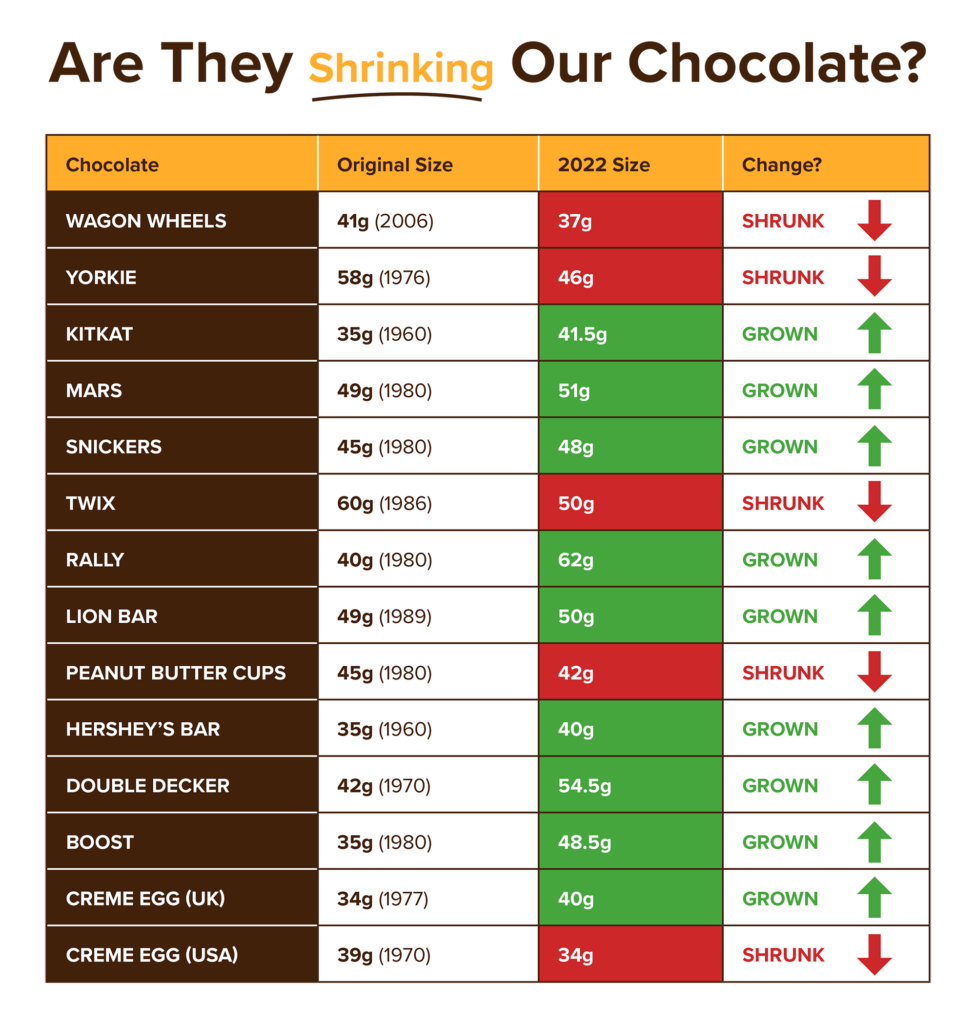Size Matters: Is Shrinkflation Stealing Our Chocolate?

We’re all feeling the pinch right now. Inflation is driving up the costs of energy, fuel and even food, turning the weekly shop into a serious financial investment. And it’s not just essentials that are seeing soaring prices either – even treats like chocolate are suffering.
Earlier this year, Cadbury announced that they were shrinking down their family-size chocolate bars by 10% in a bid to keep retail prices down. This move follows a commitment in 2021 that saw the size of the multipack bars shrink in an alleged attempt to lower the calorie counts of the bars. Understandably, among a nation of chocoholics, these steps have sparked outrage across the board.
It also reignited the long-term debate about disappearing chocolate. Every Dad has a story about the good ol’days when a Mars bar was 10p to buy and the size of your arm. But it’s hard to know if this is based on truth or just a well-worn grumble?
Back In 2015, we here at Appliance City did some pretty pioneering research on the subject, comparing data across a variety of bars and brands to discover the real size changes across the decades. And with Cadburys’ announcement ringing in our ears, we decided now was a great time to revisit and refresh our research, and see if it still held true.
Here is what we found:

So, which chocolate bars have gotten smaller?
Despite the general consensus that shrinkflation is making our chocolate smaller, out of all the ones we investigated, you might be surprised to learn that a number of chocolate bars have actually gotten bigger since they were first released. Lion bar, Kit Kat, Snickers and Boost are all bigger now than they were at inception:

Are Mars bars getting smaller?
Mars bars seem to be something of a gold standard when it comes to the shrinking chocolate debate. They definitely look smaller to us, so we were surprised to find that Mars bars have actually grown since the eighties. In fact, they’ve grown by a whole 4%.
The shock of this revelation is probably thanks to the sugar-fuelled nineties. As the nation relied on Mars bars to help them work, rest and play, the bars were a staggering 65g.
This was a short-lived glory though – by 2009 they shed a whole 15g on the sly. A small single gram bump in 2013 bought them back up to 51g which is the same weight they hold today.
How much smaller have Cadbury’s Creme Eggs got?
They actually haven’t! Another common chocolate myth harks back to the days when Creme Eggs were more the size of ostrich eggs than chicken, but this was never the case. In fact, Creme Eggs are now 6g heavier than they were in 1977, coming in at a weighty 40g. That’s an egg-stremely impressive 15% increase! (sorry)
This is only the case in the UK though. Stateside, Creme Eggs are a prime example of shrinkflation, as they’ve shrunk by nearly the same amount that UK Creme Eggs have grown. Now a microscopic 34g, they are a full 13% smaller than they were in the seventies.
This probably goes some way to explain why UK Creme Eggs are actually banned in America. Don’t want them getting jealous now, do we?
Why are Yorkie Bars so small?
Ironically, for a bar that once claimed to be so big that ‘it’s not for girls’, Yorkie’s have seriously shrunk since the seventies when it tipped the scales at 58g. Compared to its current minuscule 46g, it’s seen a 20% decrease across the decades.
And this is a case of obvious shrinkage too. You used to be able to count six chunks to a bar, but there are now only five left to enjoy.
The 20% is only half the story though. In the 2000s, Yorkies shot up to a whopping 70g (perhaps to tie with their controversial gender-driven slogan). That’s an astounding 34% decrease in less than 20 years!
Are Wagon Wheels smaller and how big did they used to be?
The shrinking Wagon Wheel question has long been discussed, and was in fact dismissed by this official statement from Burton’s biscuit company, who declared: “Contrary to popular belief, Wagon Wheels have not actually got smaller, most often our first Wagon Wheel experience is in childhood and hence our hands are much smaller.” We were determined to find out the truth where others have failed, and after much investigation we uncovered some findings that might make the Burton’s spokesperson blush.
Depending on your age (I’m not asking!) you might remember the Wagon Wheels of the 80s or before. Sometime during the 80s they saw their first reduction from a 79mm width to a 74mm width. Following this, they shrunk again sometime between their 2006 weight of 41g and today’s weight of 36g. Again this is no small change, a 12% decrease is something you’d be sure to notice.
How much did a Hershey Bar weigh in 1970?
Hershey bars prove an interesting shrinkflation study because in 1970 they were a hefty 46g and they’ve been shrinking ever since – they’re now a svelte 43g.
But (and yes, a big but) they are actually bigger now than they were when they first hit the shelves in 1960. Despite this decade being known for its liberalism, Hershey were all kinds of stingy with their first bar. It came in at a meagre 35g.
So, while the seventies saw a heavy Hershey’s heyday, in reality their bars have still grown since they were first released.
Why is chocolate shrinking?
‘Shrinkflation’ is pretty common across the food industry now. Brands shrink the size of their products rather than increase prices so that we don’t notice such a stark change at the checkout.
But when it comes to sweet treats like chocolate bars, there are other reasons at work too. Here are the three main justifications for why your chocolate bars may have shrunk:
- Health Concerns
Chocolate manufacturers maintain the driving force behind their ever-decreasing product sizes is public health concerns. To be fair the facts behind this do hold out.
With more than 2 out 3 adults already considered overweight or even obese, pressure is on junk food producers to play their part in improving public health. This pressure is not going to stop any time soon – in fact it’s highly likely to increase.
As far back as 2012, Mars pledged to cut down the ‘calorie per portion’ of their bars, and nearly 10 years later, Cadbury’s said the same about their shrinking multipacks. This is unlikely to stop anytime soon and we suspect that more shrinkage will appear on the horizon in the years.
- Global Demand
The global demand for chocolate is obviously intense as it’s such a popular product around the world. Meeting that demand is growing ever more difficult, so it could be that bars are getting smaller to allow more people to get them!
The supply chain is also tightening up. The world’s biggest source of cocoa is Ghana, home to more than 700,000 cocoa farmers. However, the Ghanaian government have capped the price that can be paid for the crop, turning it into an unprofitable option for many farmers.
Fewer farmers means less cocoa which in turn means either fewer bars or the ones we have are smaller. Clearly, the smaller option is the one currently being favoured.
- Protecting Company Profits
Shrinkflation is definitely a driving factor across recent chocolate bar size changes.
The process of producing chocolate is shooting up. Raw ingredients cost more, it costs more to run the machines that make them and the cost of importing and transporting has increased.
It figures that companies are looking to share the increases with customers rather than shoulder them alone. Research shows that most customers don’t notice shrinkflation as it actually happens, making it a great alternative for companies who are worried about scaring their customers off with price hikes (though there’s no denying we’ve seen some of those too as the year has progressed).
The reasons behind chocolate bars getting smaller are fuzzy and up for debate. But the figures involved are clear. Yes, some bars are definitely smaller but some are actually bigger than the day they hit the shelf. Clearly, different decades had different trends and many of the ‘massive’ chocolate bars that people remember were a product of their time and are no longer appropriate, or maybe they seemed bigger because those that were eating them were smaller?
However it is impossible to deny the downward trend of the last decade or so, and it is equally hard to shake the sinking feeling that this will continue. Of course, there are benefits to eating less chocolate so just make sure you savour every bite. After all, you won’t be getting as many!
You’re more than welcome to use our images in your own content, all we ask is that you credit Appliance City with a link back to this article.


